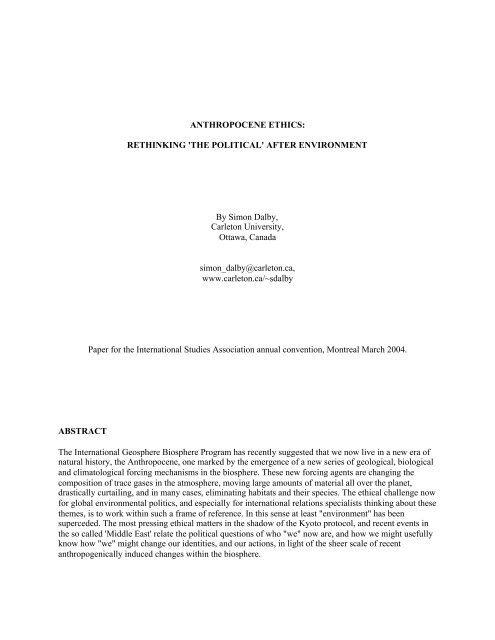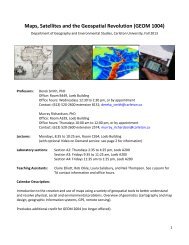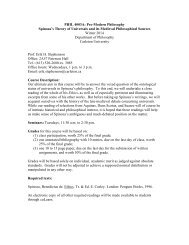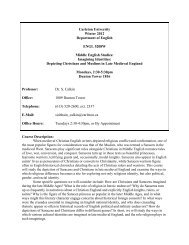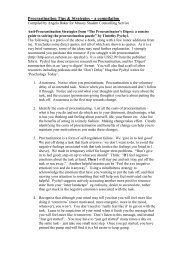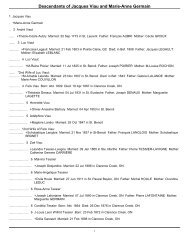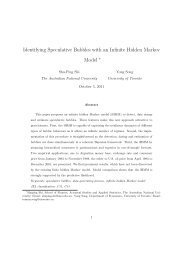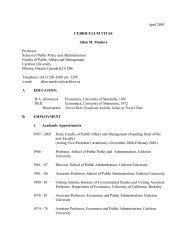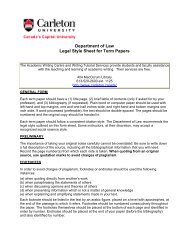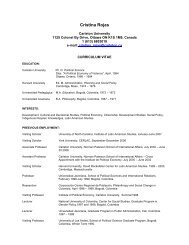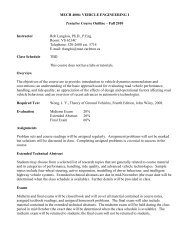anthropocene ethics: rethinking 'the political' after environment
anthropocene ethics: rethinking 'the political' after environment
anthropocene ethics: rethinking 'the political' after environment
- No tags were found...
Create successful ePaper yourself
Turn your PDF publications into a flip-book with our unique Google optimized e-Paper software.
evidence is accumulating rapidly that it has already begun. The polar regions are especially sensitive toclimate changes as residents of Northern Canada are already discovering.The more worrisome matter is the possibility of serious rapid climate change. Surprises are amatter of geological record. Rapid shifts are a results of the interconnections between parts of the earthsystem. The nearly catastrophic episode with stratospheric ozone depletion recently is a salutary warningabout the possibilities of surprise and the dangers of introducing chemicals into the global system. As theearth warms due to carbon dioxide increases there is a possibility that the "carbon sink" phenomenon willslow, hence accelerating the rate of carbon dioxide buildup due to the reduced ability of ecologicalsystems to absorb carbon dioxide. Climate change and ecosystem changes will accelerate as a result.One worrisome scenario that might occur is as a result of temperature and salinity changes in theNorth East Atlantic. There water sinks in to the ocean depths to be replaced on the surface by waterflowing in from the "Gulf Stream" that originates in the Gulf of Mexico. This "conveyor belt" of warmwater keeps Europe relatively warm and allows agriculture in the north of Scandinavia. If temperaturewarms and the salinity changes, then these waters may not sink and the "conveyor belt" may cease tofunction. Dramatic climate shifts are the likely consequence. The "common agricultural policy" mightthen be the least of European Union worries.But climate change and carbon dioxide levels are only one facet of the changes that matter. Theartificial "fixing" of nitrogen, the rapid increase in human appropriations of "natural" productivity, theextinction of avian and mammalian species not to mention the "fishing down" of the oceanic fish stocks,all interact in fashions that we don't yet understand. What is clear is that many of these relationships workin non-linear ways which will produce surprises in the future. Where the critical thresholds are we simplydon't know. There may well be negative feedback systems that counteract some of the perturbations, butthere is no reason to believe that the cascading inter-connected non-linearities will be benign to thecurrent arrangements of human civilization.ECOLOGYLiterally powered by, to adapt a Lewis Mumford (1934) term, "carboniferous capitalism", these newforcing agents are changing the composition of trace gases in the atmosphere, moving large amounts ofmaterial all over the planet, drastically curtailing, and in many cases, eliminating habitats and theirspecies. A medium sized mammal species has run completely amok. The challenge now is for scholarswho deal with global politics to think about their projects within such a frame of reference, whetherunderstood in terms of the Anthropocene, or in terms of an historical era of novelty, an era when there isliterally "something new under the sun" (McNeill, 2000). Environment is no longer the taken for grantedbackdrop for the human drama. In that sense we live in a period of human induced change beyond aconcept of nature understood as the context for humanity. In that sense we now live "<strong>after</strong>" <strong>environment</strong>.Ecology, and more explicitly the questions of system transformation captured in the termpanarchy (Gunderson and Holling, 2002) is frequently antithetical to conventional modes of knowing andadministrating. Herein lies a major difficulty. It is in part difficult because the assumptions of regulation,as with so much of "scientific" research, is that reality is specifiable in terms of stable entities. Precisesurveying and territorial demarcations of such things as park boundaries produce knowledge andmanagement practices that are antithetical to ecological complexity. The society that produces suchknowledge and such assumptions of an external precisely demarcatable external <strong>environment</strong> is thecarboniferous capitalism that is causing the problem in the first place. In this sense too ecology hasrendered <strong>environment</strong> as a stable external context an untenable premise for thinking. Hence we "<strong>after</strong>"<strong>environment</strong> in this sense too.All of which suggests that thinking about connections across boundaries, seen or unseen, is key toboth physical and human sciences. Thinking seriously about consumption means thinking about therelationships between here and there, the unseen and unconsidered actions in the cities havingconsequences at a distance, and frequently in other jurisdictions (Princen, Maniates and Conca, 2002).Most explicitly, research on commodity chains is a very useful way to cut through the human/<strong>environment</strong>al divide showing both the ecological consequences of production and the persistence of4
as matters of culture and identity, concerns of who we are, and hence the legitimate forms of activity that'we' undertakes. Thinking in terms of the Anthropocene suggests that <strong>environment</strong>al categories of"nature", "parks", wilderness and pollution are simply not adequate terms for what needs to be discussed,however necessary they are in the current practices of "management".CULTURE AND ENVIRONMENTThe first casualty of earth system science is the assumption, which so frequently underlies<strong>environment</strong>alist thinking, that some notion of untouched, because unpolluted, nature is the basis for an"<strong>environment</strong>al" <strong>ethics</strong>. The assumptions that structure "deep ecology", those of pristine nature asintrinsically valuable and the source of ethical conduct, are radically challenged by the ontologies ofinterconnection that contemporary ecology has now made unavoidable. The premises of eco-feminism, ofwomen as the givers of life with consequent intrinsic connections to nature, are belied these days by themodes of consumption that structure the automobile based modes of suburban homemaking.The problem here is, in part, with the frequent aestheticization of <strong>environment</strong>al sensibility and itsincorporation into discourses of hygiene, modes of practice that are so frequently very violent operationsof cleansing and separation. Likewise with the appropriation of virtue to suburban domesticity, whileforgetting the consequences of the modes of consumption that make such "lifestyles" possible. Thelengthy commodity chains, at the heart of the trading patterns of contemporary empire (Talbot, 2002), thatmake these modes of being possible are essential to urban existence. And its that urban life that producesacademic texts about international relations and global rivalries based on liberal assumptions of autonomyand rights. These urban modes of life also produce romantic reactions to the violence and ugliness ofindustrialization which shape "<strong>environment</strong>al" sensitivities in numerous aesthetic forms.The romantic reaction to urban and industrialized modes of destruction, so magnificently reprisedin Peter Jackson's contemporary cinemagraphic rendition of J.R.R. Tolkien's "Lord of the Rings" trilogy,is revealed here as a powerful cultural construction at the heart of the <strong>environment</strong>al problematique. Thepoint is that much of the <strong>environment</strong>alist literature is an urban literature. (Environment comes from theterm 'environ' frequently meaning that which surrounds a town, so the term is in that sense an urbaninvention.) Its view of "nature" is that of urban residents, not those of rural residents who live within itsdirect ambit and who wrest a living directly from soil, forest or sea (Dalby, 2003a). Invoking Tolkienallows us to see the politics of the representations of <strong>environment</strong>, and challenge the subjectivity of theurbanites who compose <strong>environment</strong>alist tracts and frequently write <strong>environment</strong>al impact statements andresource management manuals.The themes of contemporary geopolitics resonate remarkably with Tolkien's formulations, inparticular with the Two Towers volume. Even if some of the analogies are somewhat stretched,nonetheless they provide a metaphorical repertoire for drastically <strong>rethinking</strong> many things. This requires asimple recognition that the suburbanites who cheer on Frodo and Merry, Gandalf and Aragorn in themovie theatres, are in fact residents of Mordor and Isengard, not of the Shire. Viewed thus the worlddominated by the two towers resonates all too eerily with September 11 th when two towers were attackedand destroyed by agents from the periphery of the global economy. The leader of these forces, a man witha long beard, a penchant for cloaks and, despite his need to walk with the aid of a walking stick, amiraculous habit of disappearing into the remote mountains where the surveillance systems of the towershave great difficulty finding him, remains elusive and inspirational to his followers who faceextraordinary odds in resisting the encroachment of military machines. Massive attacks on remotemountain hideouts seem to be ineffective in flushing him out and destroying him; no matter how powerfulthe ideological spells induced on the local populations by forces inhabiting the towers, the leader of theopposition remains at large.Admittedly reading Tony Blair as Sarumon, and the Project for a New American Century as thedark Lord Sauron, may stretch credulity, but this rhetorical inversion of the assumed loyalties ofcontemporary movie goers suggests the importance of understanding the urban culture, as one thatdepends on controlling resources and the peoples in the periphery to ensure the supplies of materialscontinue to flow to the metropoles. The mountain regions of Afghanistan may not be a good analogy with7
Helm's Deep, but nonetheless the overall parallel is disturbingly suggestive. The violence set loose on theplanet by the expansion of the power of Mordor loosely analogizes the destruction of numerous peoplesand modes of livelihood that are the consequence of the rapid expansion of imperialism in the nineteenth,and urbanization in the twentieth, centuries. Resistance in the peripheries and the violence entailed in theextraction of resources there is now discussed as a matter of "shadow globalization" (Jung, 2003).But what about Treebeard and the Ents? Earth system science suggests the possibility ofunanticipated surprises as a result of the changing ecological systems; the Ents' destruction of Isengard,an eventuality beyond Sarumon's capability to anticipate, suggests that nature may yet have its "revenge"on human imperial hubris. While Tony Blair may be well aware of the possibilities of oceanic disruptionof the contemporary climate system, little in the policies of many parts of the industrialized world suggestthat the climatological "Ents" are getting the attention that contemporary discussions of the Anthropocenesuggest they deserve.ONTOLOGY AND INTERNATIONAL RELATIONSThe point of such excurses into the realms of "culture" is to reiterate the importance of understanding theassumptions that structure the identities in play in contemporary international relations discourse. Itemphasizes the urban liberal consumer as the writer of <strong>environment</strong>alist tracts and social science.Understanding this "positionality" of social scientists as residents of Mordor, is key to reimagining thepossibilities of acting ethically in a biosphere where security is usually understood in spatial tropes andwhere the assumption of nature as external to humanity structures political discussions (Dalby, 2002). Thepoint about earth systems sciences and the Anthropocene is that these assumptions are no longer validpremises for discussion if contemporary knowledge is at all relevant to discussions about the humancondition.The vocabularies within which an "Anthropocene <strong>ethics</strong>" might be written are currently notobviously available; the ontologies of autonomy and separation on the one hand and mechanical causalprinciples on the other, are not the conceptual tools we need. Environmentalist tropes of pristine naturesuggest the importance of minimizing alterations of many habitats; but so many habitats are nowobviously "artificial" that the invocation of a preservationist ethos is frequently inappropriate if ecology,rather than aesthetics, is considered as the basis for policy prescription. The difficulty here is that ecologyis all about change (Levin, 1999); habitats and species come and go while separations between species,the managerial ethos of orderly landscapes and hygienic tropes, is denied by the boundary crossingrealities of material flows (Forsyth, 2003).In Christian theological terms the much quoted line from Genesis about humanity as havingdominion over nature, can now simply be read as a statement of fact; this is the point of theAnthropocene. It isn't a matter that can any longer be discussed in terms of its moral implications for thefuture, or a formulation that theories of animal rights or <strong>environment</strong>al <strong>ethics</strong> can discuss in terms ofliving lightly on the earth, but rather it has become the given context for discussion (Sanderson et.al2002). In McNeill's terms (2000), again borrowed from biblical language, there now is Something NewUnder the Sun. The additional point is simply that ecology no longer allows us the possibility offormulating matters as one of a humanity separate from nature. This is now simply ontologicallyimpossible; formulations premised on such a dichotomy make no practical sense in light of earth systemscience at the largest scale. Although it is beyond the parameters of this paper, it is worth noting that thesame debate is also taking place at the smallest scales in terms of genetic engineering, the patenting of lifeand the ethical debate about "designer" babies (Redclift, 2001).The sheer difficulty of thinking intelligently about the biosphere is immense. The difficulty ofgrasping the nuances of connection even with the extraordinary cartography made possible by satellitesensors and geographical information systems remains considerable; the visualization possibilities thatmay yet work to shift cultural sensibilities are in their infancy. The view from the satellite is acartographic representation of the view from above, the "God trick" view, that may not necessarily fostera sensibility of connection and contingency of impermanence and motion in the face of metaphysicalconstructs that emphasize truth and reality in terms of permanence, unity and stability (Thomashow,8
none the less the basis of this is an ethic of not externalizing the costs of consumption by imposingdisruptions, toxics or pollution on others.But the more traditional concerns with <strong>environment</strong> as the rural, the surrounds of the cities, thebackdrop to metropolitan life, also need attention. But in so far as the first principle above, that ofreducing material throughputs, is followed some of the pressures on rural lands, waters and biodiversitywill be reduced. But that said it is clear that a seventh principle is needed that encompasses the crucialpoint about trying to maintain ecological diversity where at all possible to keep future options open.Agriculture has long been a major factor in the disruption of habitat, a category related to enlightenmentnotions of wilderness as unproductive and the need to improve land to make it valuable. But suchdichotomies are now rendered impossible by Anthropocene thinking. Habitats are key to maintainingecological diversity and need to be understood as essential to the health of any species; they are real genebanks which facilitate innovation, adaptation and evolution, unlike the stasis of artificial storage proposedby many technically focused discussions of diversity preservation. But they need to be interconnected sothat animals, birds and plants can move and adapt to changing circumstances. Artificial linear barriers likeroads, and areal barriers like cities and fields, compromise mobility in dangerous ways for many species.Put together these in sum amount to an ethic of care directed to life, something akin to an ethic offlourishing in Cuomo's (1998) terms. Most important is the cultural dimensions of these insights. Sauron'sfantasy of complete domination and perpetual power, the hubris of imperial aspiration is the industrialfantasy of modernity, of the whole world as malleable to a single will. But if the understanding ofinterconnection is to be fostered the cultural tools necessary are at least in part being forged in the postindustrialtechnologies of representation and communication. While so much of the ephemeralconsumption online is just that, nonetheless the importance of the ephemeral connection is crucial both tothe possibilities of <strong>rethinking</strong> politics, and the possibilities of <strong>ethics</strong> that understand that the distant unseenstranger and the distant unknown field or factory, is irremediably tied into who we who "log on" actuallyare. Languages of complexity theory and ecological interconnection provide alternative modes ofunderstanding that transcend the metaphysical formulations of autonomy and separation as liberal ontotheologicalaspiration (See Dalby, 2003b).Above all Anthropocene thinking requires that the contemporary discussions of global changeand globalization be merged into one. The flows across boundaries, of people, materials, fuel andpollution that are the source of concern to many who study "globalization" are precisely the processes thatare forcing the biospheric system in the new ways that so worry scientists working with the IGBP.Ironically this pattern makes more sense if matters are viewed in terms of the imperial dimensions ofglobal trading where peripheries supply the raw materials for production plants that provide thecommodities for the metropoles (Dalby, 2003c). Shadow globalization and the disruptions caused by theexpansion of modernity into remote parts of the world's polity (Jung, 2003), is an important part of whatthe destruction of the "wild" is all about (Sanderson, et.al. 2002).But the question of the political forms of sufficiency remain important too; as Peter Stoett (2003)notes the centralized security state is a requirement for the reintroduction of nuclear power as a legitimateenergy supply system, a political campaign spurred on by the use of global warming concerns. In so far asstates function to secure consumption and the supplies of resources through the global economy they arefrequently intensifying the changes in the flows of materials through ecological systems. Road building,and the promotion of car culture as a development strategy in many places, is only the most obviousmanifestation of this political difficulty; states are building the infrastructure that is changing thebiosphere. Expecting them to regulate <strong>environment</strong>al matters effectively so long as this remains theirdominant goal is not the basis of either an effective domestic strategy or regime building (Paterson, 2000).Intelligent land use planning remains but a dream in the suburbanization of many places wheredevelopers' prerogatives so frequently hold sway in municipal politics (Davis, 2002).The overarching requirements of Anthropocene thinking suggest principles very considerablydifferent from the contemporary focus in neo-liberalism on self-governance, international efficiency andthe whole technocratic panoply of mechanisms of ecological modernization. Tom Princen (2003) suggeststhat the theme of sufficiency is an essential prerequisite for reforming international <strong>environment</strong>al10
Le Billon 2003 "Getting it Done: Instruments of Enforcement" in Ian Bannon, and Paul Collier eds.Natural Resources and Violent Conflict: Options and Actions Washington: The World Bank. 215-286.Levin, Simon 1999. Fragile Dominion: Complexity and the Commons Reading, MA: Perseus.Lovins, A.B. 1977 Soft Energy Paths Harmondsworth: Penguin.Magnusson, Warren and Karena Shaw (eds) 2002. A Political Space: Reading the Global throughClayoquot Sound Montreal and Kingston: McGill Queen's Press.Mackenzie, Fiona and Simon Dalby 2003. "Moving Mountains: Community, Nature and Resistance in theIsle of Harris, Scotland, and Cape Breton, Canada" Antipode 35(2): 309-333.McKibben, Bill 1989. The End of Nature New York: Random House.McNeill, J. R. 2000. Something New Under the Sun: An Environmental History of the Twentieth-CenturyWorld New York: Norton.Mumford, L. 1934. Technics and Civilization New York: Harcourt, Brace and World.Paterson, Mat 2000. Understanding Global Environmental Politics London: Macmillan.Peluso, Nancy and Michael Watts (eds) 2001. Violent Environments Ithaca: Cornell University Press.Petit, J.R. et al. 1999 "Climate and Atmospheric History of the past 420,000 years from the Vostok IceCore, Antartica" Nature 399. 3 June 429-436.Princen, Thomas, 2003. "Principles for Sustainability: From Cooperation to and Efficiency toSufficiency" Global Environmental Politics 3(1): 33-50.Princen, Thomas, Michael Maniates and Ken Conca (eds) 2002. Confronting Consumption Cambridge,MA: MIT Press.Redclift, Michael 2001. "Environmental Security and the Recombinant Human: Sustainability in theTwenty First Century" Environmental Values 10: 289-299.Renner, Michael 2003. "Oil and Blood: The Way to Take Over the World" Worldwatch Magazine 16(1):19-21.Robinson, Fiona 1997. "Globalizing Care: Ethics, Feminist Theory and International Relations"Alternatives 22(1): 113-133.Sachs, W.; Loske, R.; & Linz, M. 1998. Greening the north: A post-industrial blueprint for ecology andequity. London: Zed Books.Sanderson, Eric W, Malanding Jaiteh, Marc A. Levy, Kent H. Redford, Antoinette V. Wannebo andGillian Woolmer 2002. "The Human Footprint and the Last of the Wild" BioScience 52(10): 891-904.Shah, Saubhagya 2002. "From Evil State to Civil Society" South Asian Himal November, 10-17.Stott, Philip and Sian Sullivan eds. 2000. Political Ecology: Science, Myth and Power London: Arnold.Stoett, Peter 2003. "Toward Renewed Legitimacy? Nuclear Power, Global Warming and Security" GlobalEnvironmental Politics 3(1): 99-116.Talbot, John M. 2002. "Tropical commodity chains, forward integration strategies and internationalinequality: coffee, cocoa and tea" Review of International Political Economy 9(4): 701-734.Thomashow, Mitchell 2002. Bringing the Biosphere Home: Learning to Perceive Global EnvironmentalChange Cambridge, MA: MIT Press.United Nations Environment Program, 2002. Global Environment Outlook 3 London: Earthscan.Wapner, P. 2003. "World Summit on Sustainable Development: Towards a Post-Jo'burgEnvironmentalism" Global Environmental Politics 3(1): 1-10.Worldwatch Institute 2004. State of the World New York: Norton.14


